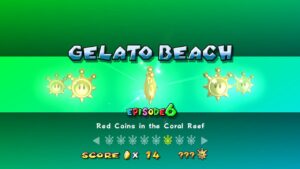 Super Mario Sunshine released in 2002 for the Nintendo GameCube. Being the follow up to Super Mario 64, Sunshine improved what 64 had built without feeling too different. Many gamers that grew up with a GameCube fondly remember Sunshine. This review will use the Super Mario 3D All-Stars version as it is the most accessible version of Sunshine.
Super Mario Sunshine released in 2002 for the Nintendo GameCube. Being the follow up to Super Mario 64, Sunshine improved what 64 had built without feeling too different. Many gamers that grew up with a GameCube fondly remember Sunshine. This review will use the Super Mario 3D All-Stars version as it is the most accessible version of Sunshine.
Story

Mario in court.
Sunshine begins with Mario and Princess Peach on their way to Isle Delfino for a vacation. Upon arrival to the island, they see slime covering the ground. After grabbing F.L.U.D.D, Mario begins his task of cleaning the slime. As Mario cleared the slime, he learned that someone had framed him for this crime. Mario is tasked with cleaning the island while trying to stop the person committing identity fraud. This is a different story in comparison to other Mario games. At the start of the game Mario’s tasks revolve around community service while trying to restore the island. Sure, while Peach does get kidnapped eventually, this event happens halfway through the game. Many players by this point know Shadow Mario’s ulterior motive.
Gameplay
 Being the second 3D Mario title, the gameplay remains largely the same between the two. The goal of each level is to complete the objective and collect Shine Sprites. Mario is still able to run and jump, but rather than punching and kicking, Mario has access to the F.L.U.D.D pack. A backpack that shoots water and helps Mario with his platforming. Mario’s primary nozzle is the spray nozzle. This allows him to spray a stream of water in front of him or at enemies. The hover nozzle allows Mario to float in the air for a short time. This allows players to briefly correct mistakes with jumps. The rocket nozzle allows Mario to charge one big jump while the turbo nozzle allows Mario to run at a faster speed. These nozzles have more specific uses for certain shines. However, most objectives have no need for them.
Being the second 3D Mario title, the gameplay remains largely the same between the two. The goal of each level is to complete the objective and collect Shine Sprites. Mario is still able to run and jump, but rather than punching and kicking, Mario has access to the F.L.U.D.D pack. A backpack that shoots water and helps Mario with his platforming. Mario’s primary nozzle is the spray nozzle. This allows him to spray a stream of water in front of him or at enemies. The hover nozzle allows Mario to float in the air for a short time. This allows players to briefly correct mistakes with jumps. The rocket nozzle allows Mario to charge one big jump while the turbo nozzle allows Mario to run at a faster speed. These nozzles have more specific uses for certain shines. However, most objectives have no need for them.

Red coins do not show up in other levels and must be completed in order
Many players were disappointed that level progression remained the same from 64. Each level is split into multiple missions and completing a mission unlocks the next one. Exploring missions out of order was SM64’s design. Many missions in Sunshine, however, must be tackled in order. This creates a linear feeling in many of the level designs. While not a bad decision, it feels like a step backward in comparison to what 64 did.
Graphics

Pinna Park. One of the more colorful locations
Visually speaking, Super Mario Sunshine still holds up well to this day. Each level of Isle Delfino is designed to capture the feel of an island resort. The use of bright and vibrant colors perfectly captures the island along with its inhabitants. Darker levels like Hotel Delfino or Pianta Village at night still captures an island resort’s night life. Many characters in this game also stand in the same way as well. Compared to previous games, Mario and Peach received updated designs that would be the standard design for future games.
While many GameCube games still hold up well in today’s standard for gaming; Super Mario Sunshine is a game that still has a dedicated fanbase. Being one of the more unique Mario games and having a large speed running community, Sunshine had gamer’s interest. Prior to the release of 3D All-stars, many gamers believed this game would never see a modern port. Super Mario Sunshine is a game that many gamers will look back on with fond memories.
